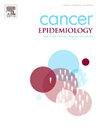拉丁美洲成人t细胞白血病/淋巴瘤的患病率和生存结局:一项多中心队列研究和改善诊断和结局的建议
IF 2.3
3区 医学
Q3 ONCOLOGY
引用次数: 0
摘要
尽管与北美或欧洲国家相比,成人t细胞白血病/淋巴瘤(ATL)在拉丁美洲的负担更高,但很少有研究描述这种疾病的结局。我们估计了ATL的医院患病率和总生存率(OS)。方法:我们对2000年至2023年11个拉丁美洲国家病理诊断为成熟t细胞淋巴瘤的年龄≥ 18岁的患者进行了一项队列研究,汇集了来自3个医院登记处的数据。我们使用Kaplan-Meier方法来估计生存结果。结果在1963例成熟t细胞淋巴瘤患者中,ATL的总患病率为17 % (n = 329;95 %置信区间[CI]= 15-18 %),秘鲁最高( = 158;38 %,95 % CI= 33-43 %)和哥伦比亚(n = 17;29 %,95 % ci = 18-41 %)。随着时间的推移,ATL病例仅在秘鲁显著增加,从2000-2004年的14% %增加到2019-2023年的58% % (p趋势<;0.001)。中位随访37个月(95 % CI= 30-54个月),ATL 3年OS为25 %(95 % CI= 20-32 %),中位OS为9个月(95 % CI= 8-12个月)。OS在不同国家间无差异(范围19-47 %,P = 0.210)。在秘鲁,淋巴瘤ATL患者的预后比单纯PTCL-NOS患者差(异质性=0.029)。结论:我们的研究结果表明,拉丁美洲的ATL患病率高于先前报道的北美或欧洲,这可能是由于HTLV-1流行和诊断方法的差异。各国的存活率相似且较低,这突出表明需要采取有针对性的干预措施来改善患者的预后。我们建议以专家为基础的研究重点,并建议进一步进行流行病学验证研究。本文章由计算机程序翻译,如有差异,请以英文原文为准。
Prevalence and survival outcomes of adult T-cell leukemia/lymphoma in Latin America: A multicenter cohort study and recommendations to improve diagnosis and outcomes
Background
Although adult T-cell leukemia/lymphoma (ATL) has a higher burden in Latin America compared to North American or European countries, few studies have described the outcomes of this disease. We estimated the hospital-based prevalence and overall survival (OS) of ATL.
Methods
We conducted a cohort study among patients aged ≥ 18 years with pathologically diagnosed mature T-cell lymphoma across 11 Latin American countries from 2000 to 2023 by pooling data from 3 hospital-based registries. We used the Kaplan-Meier method to estimate survival outcomes.
Results
Among 1963 patients with mature T-cell lymphoma, the pooled prevalence of ATL was 17 % (n = 329; 95 % confidence interval [CI]=15–18 %), with the highest observed in Peru (n = 158; 38 %, 95 % CI=33–43 %) and Colombia (n = 17; 29 %, 95 % CI=18–41 %). Over time, ATL cases only increased significantly in Peru, from 14 % in 2000–2004 to 58 % in 2019–2023 (Ptrend<0.001). With a median follow-up of 37 months (95 % CI=30–54 months), the 3-year OS of ATL was 25 % (95 % CI=20–32 %), and the median OS was 9 months (95 % CI=8–12 months). OS did not differ across countries (range 19–47 %, P = 0.210). Patients with lymphomatous ATL had worse outcomes than those with PTCL-NOS only in Peru (Pheterogeneity=0.029).
Conclusion
Our findings indicate a higher ATL prevalence in Latin America than previously reported in North America or Europe, likely due to differences in HTLV-1 endemicity and diagnostic practices. The similar and poor survival rates across countries underscore the need for targeted interventions to improve patient outcomes. We propose expert-based research priorities and suggest further epidemiological validation studies.
求助全文
通过发布文献求助,成功后即可免费获取论文全文。
去求助
来源期刊

Cancer Epidemiology
医学-肿瘤学
CiteScore
4.50
自引率
3.80%
发文量
200
审稿时长
39 days
期刊介绍:
Cancer Epidemiology is dedicated to increasing understanding about cancer causes, prevention and control. The scope of the journal embraces all aspects of cancer epidemiology including:
• Descriptive epidemiology
• Studies of risk factors for disease initiation, development and prognosis
• Screening and early detection
• Prevention and control
• Methodological issues
The journal publishes original research articles (full length and short reports), systematic reviews and meta-analyses, editorials, commentaries and letters to the editor commenting on previously published research.
 求助内容:
求助内容: 应助结果提醒方式:
应助结果提醒方式:


